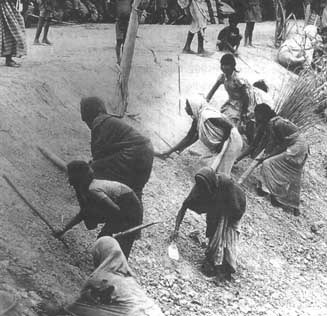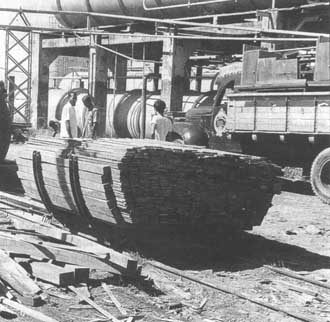FAO Asia-Pacific forestry commission
Chile holds national biodiversity symposium
Forestry workforce network formed
The 15th session of the Asia-Pacific Forestry Commission was held in Colombo from 9 to 13 August 1993 at the invitation of the Government of Sri Lanka. The session was attended by participants from 13 member countries, representatives from the United Nations Development Programme (UNDP) and the World Food Programme (WFP) and observers from the Asian Development Bank (AsDB), CARE International, the international Union of Forestry Research Organizations (IUFRO) and the World Conservation Union (IUCN).
In the keynote address, the Sri Lankan Minister of Lands, Irrigation and Mahaweli Development provided an overview of the paradoxical situation of the region, where vibrant economic transformation, rapid population growth and inequitable distribution are leading to ever-increasing demands on the regions limited but essential forest resources. In fact, according to the latest available data, per caput forest cover was the lowest of the three tropical regions and the rate of deforestation was the highest. At the same time, concern for sustainable forestry development was high and increasing, as evidenced by the 1993 global forestry conference, "Beyond UNCED - Response to Agenda 21", held in Bandung, Indonesia.

State of forestry in the region
The Commission noted that policies in a number of countries were evolving to accommodate changing priorities relative to forest management. Many countries reported a change in emphasis from traditional timber-oriented management to broader management approaches that stress a wider range of forest products and environmental services.
Many countries were undergoing significant structural shifts within the forestry sector as commercial log harvests were reduced; countries struggled with the transition from wood-surplus to wood-deficit conditions; industries adjusted from processing large-diameter, old growth logs to smaller-diameter wood from plantations and secondary forests; and increasing use was made of lesser-known species, non-traditional raw materials and non-wood products. It was noted that nearly all countries of the region were placing a renewed emphasis on plantation establishment, the restoration of degraded lands and regreening programmes.
Follow-up to UNCED decisions on forestry in the Asia-Pacific region
The Commission recognized the numerous recommendations made by UNCED with particular relevance for the Asia-Pacific region, including the need for integrated land-use planning, intensified forest resource assessments, improved forest management, expanded support for community forestry, integrated mountain development, full development of the potential of non-wood forest products and intensified conservation of forest genetic resources.
The Commission further agreed that UNCED follow-up must be directed and planned at the national level and implemented on the ground primarily by national and local institutions.
Women and forestry
The Commission discussed gender issues in forestry on the basis of a presentation by Prof. Anoja Wickramasinghe (University of Peradeniya, Sri Lanka), who had conducted extensive studies on women's participation in forestry; and a video on gender analysis produced by FAO's Forests, Trees and People Programme.
The Commission noted numerous constraints that prevent women from fully participating in forestry development, including lack of tenure rights to land and trees; institutional and cultural constraints; male-dominated community organizations; lack of access to credit and technology; and lack of access to training.
The Commission urged forestry departments, project managers and all forestry officials to work towards removing these constraints.
The Commission cited the dearth of women participants at the session as evidence of the failure of the forestry profession to engage women effectively at the highest levels of forestry decision-making, and it pledged to increase the number of women at future sessions.
FAO forestry activities of interest the region
Review of 1990-93 activities and Programme of Work and Budget for 1994-95. The Commission was informed of the FAO forestry programmes carried out during the 1990-93 period and of the planned programmes for 1994-95. It reiterated views expressed earlier in deliberations on UNCED follow-up for the need for FAO to focus its limited energy and resources in areas where it had a comparative advantage. The Commission reaffirmed its highest priority ranking for forest resources assessment and monitoring, support to TFAP and country capacity-building, and it expressed considerable satisfaction with FAO's continuing production of high-quality and useful publications.
Forestry field Programme in the region. Annual funding of FAO forestry field projects in the region stood at US$ 13.5 million in 1992, with approximately two-thirds of funding for field projects coming from UNDP. The largest numbers of forestry field projects in the region were in community forestry, agroforestry and reforestation, watershed management and sustainable forest management -reflecting the region's current priorities.
The Commission noted the difficulty that some countries had in providing qualified full-time counterparts to work with internationally supported projects and recognized that this further underscored the need for country capacity-building.
Progress in the implementation of the Forestry Research Support Programme for Asia and the Pacific (FORSPA). In considering the activities and accomplishments of FORSPA since its formal establishment in 1991, the Commission highly praised the efforts of the late Dr Y.S. Rao who, as FORSPA's first Senior Programme Adviser, had untiringly worked to establish FORSPA and successfully initiated a wide range of activities. The Commission acknowledged the role played by FORSPA in promoting collaboration of the research institutions in the region and encouraged further development. It emphasized that the duplication of efforts with other international forestry research organizations, for example the Centre for International Forestry Research (CIFOR) and the International Union of Forestry Research Organizations (IUFRO), should be avoided
Forestry investment in Asia and the Pacific
The Commission held an in-session seminar on investment under the Tropical Forests Action Programme (TFAP) and Master Plan (MP) initiatives in the Asia and the Pacific region. This offered an opportunity for participants from recipient countries to share experience in attracting funding for forestry (judged to be meagre by the previous session of the Commission) and for participants from donor countries to brief the participants on new developments that may influence the availability of investment resources.
The Commission noted that, overall, the Asia and the Pacific region had performed better than other regions in attracting external investment to forestry through the TFAP/MP framework. However, it was recognized that a few countries in the region receive the bulk of the funds from donors, while several other countries receive very little external assistance.

The discussions led to the general conclusion that improved productivity and economic gains were the most important factors influencing investment flows. Adherence to efficiency criteria, irrespective of whether programmes were socially oriented or production-driven, whether undertaken by private or public sector or whether loans or grants were involved, was considered critical In order to attract investment. This was viewed as especially crucial if private sector investment was desired. The Commission also recognized that early consideration of market factors, potential downstream processing potentials and the true costs of production would help to attract private sector forestry investment.
In April 1993, the National Forestry Corporation of Chile (CONAF) organized a symposium entitled "Priority sites for the conservation of biological diversity in Chile". Held at the FAO regional office in Santiago, the event was attented by more than 100 scientists and technicians from all over the country. The purpose of the seminar was to establish a consensus on the sites that should be accorded the highest priority for conservation activities to ensure species diversity and conservation of habitats and unique communities. An important conclusion was an agreement on 20 sites, possessing a great abundance of species, a diversity of habitats and/or unique communities which are highly threatened by human impact and therefore require "urgent" conservation efforts. An additional 52 sites meriting conservation attention, but not as yet under threat from human activity, were also identified. The proceedings of the symposium will be published as the Red book on priority sites for the conservation of biological diversity in Chile. This document will join previously published "red books" following symposia organized by CONAF in 1985 and 1987 and treating, respectively, "Tree and bush flora in danger of extinction" and "Land fauna in danger of extinction". These proceedings serve as the country's official reference documents on matters concerning the state of conservation of native species.
Source: Chilean For. News., 16(179): 4-5.
The FAO/ECE/ILO Joint Committee on Forest Technology, Management and Training is launching a new international network, called FORWORKNET, to deal specifically with issues related to the forestry workforce. The network, hosted and supported by the Industrial Activities Branch of the International Labour Office in Geneva, is intended to open new opportunities for international exchange and collaboration among the forestry workforce. FORWORKNET will deal with all aspects of the forestry workforce:
Human resources development
· Supply/demand for forest work
· Recruitment
· Retention
· Changing nature of jobs
· Environmental connections
· Workforce development paths
· Contractors in forestry
· Women in forest work
· Migrant labour
· Training and extension
Productivity
· Work organization
· Mechanization
· Worker-technology interfaces
· Decision-making in forest work
· Benefit/cost of improvements
Social and labour issues
· Employment in forestry
· Forest-dependent communities
· Working conditions
· Pay and benefits
· Labour-management relations
· Occupational safety and health
· Ergonomics and human engineering
Specifically, the network will endeavour to keep members abreast of new developments, new publications, data and research results, forthcoming events, new technologies and other relevant news. It will also develop its own specialized databases for references and statistics.
FORWORKNET is open to interested individuals and organizations worldwide. Members are expected to come from government forest services and labour administrations; employers' and workers' organizations; forest enterprises; contractors; forest owners; vocational schools and colleges; universities; research institutes; international organizations; technical assistance agencies; and independent consultants. Membership is free of charge. To obtain a FORWORKNET registration form, write to Dr P. Poschen, Industrial Activities Branch, ILO, 4 route des Morillons, CH-1211 Geneva 22, Switzerland.